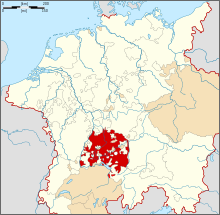Fürst von der Leyen und zu Hohengeroldseck
Fürst von der Leyen und zu Hohengeroldseck was a German noble title of the House of Leyen.
Freiherr (Baron) von der Leyen und zu Hohengeroldseck
- 1692 – 17 July 1704: Johann Nikolaus (1633 – 1704)
- 1705 – 22 November 1711: Karl Kaspar Franz (1655 – 1739)
Reichsgraf (Count) von der Leyen und zu Hohengeroldseck
- 22 November 1711 – 20 November 1739: Karl Kaspar Franz (above)
- 20 November 1739 – 16 February 1760: Friedrich Ferdinand Franz Anton (1709 – 1760)
- 16 February 1760 – 26 September 1775: Franz Georg Karl Anton (1736 – 1775)
- 26 September 1775 – 12 July 1806: Philipp Franz Wilhelm Ignaz Peter (1766 – 1829)
Fürst (Prince) von der Leyen und zu Hohengeroldseck
- 12 July 1806 – 23 November 1829: Philipp Franz Wilhelm Ignaz Peter (above)
- 23 November 1829 – 17 May 1879: Karl Eugen Damian Erwein (1798 – 1879)
- 17 May 1879 – 24 July 1882: Philipp Franz Erwein Theodor (1819 – 1882)
- 24 July 1882 – 18 September 1938: Erwein Theodor Philipp Damian (1863 – 1938)
- 18 September 1938 – 13 February 1970: Erwein Otto Philipp Leopold Franz Joseph Ignatius (1894 – 1970)
- 13 February 1970 – 9 September 1971: Ferdinand Maria Erwein Harthard Antonius Michael Joseph (1898 – 1971)
- 9 September 1971: Philipp Erwein Konrad Alfred Eugen Bonifatius Melchior Georg Arbogast Frhr von Freyberg-Eisenberg (1969)
- 22 November 1990: Wolfram, Hereditary Prince of Leyen and zu Hohengeroldseck (b.1990)
gollark: What?!
gollark: ❗
gollark: Appearance/Basic Anatomy Their golden scales retain heat better than other dragons. The twin dorsal fins at their shoulders grow slowly. When first born, the golden scales are at their brightest and then dull over time. The dorsal and tail spines are not sharp. The underbelly has harder scales than the rest of the body. Three digits on each wing, with a small claw-like digit at the central joint. Eyes have slit pupils that are bright apple green. The tail is prehensile to a degree and helps steady movements.Hatchling Behavior Hatchlings are timid but curious. At a young age, scales start out sharp. When encountering other metallic dragons, Golds become very talkative. They can’t do much flying until the twin dorsal fins are long enough.Adult Behavior Can be persnickety at times. Absolutely love objects as shiny as they are. Being hunted for their lustrous scales has made them tend to avoid humans. Dislike direct sunlight when in groups. Highly intelligent compared to other breeds. Have studied humans to a small degree but are not particularly impresssed with them.Habitat Can be found near caves. Hatchlings tend not to stay where they are supposed to. Prefer dense wooded areas.Diet Primary diet of large game and pack animals. Are careful to avoid killing off entire herds. “Snack” on nuts, if available.
gollark: Gold what?
gollark: INdeed.
References
This article is issued from Wikipedia. The text is licensed under Creative Commons - Attribution - Sharealike. Additional terms may apply for the media files.
